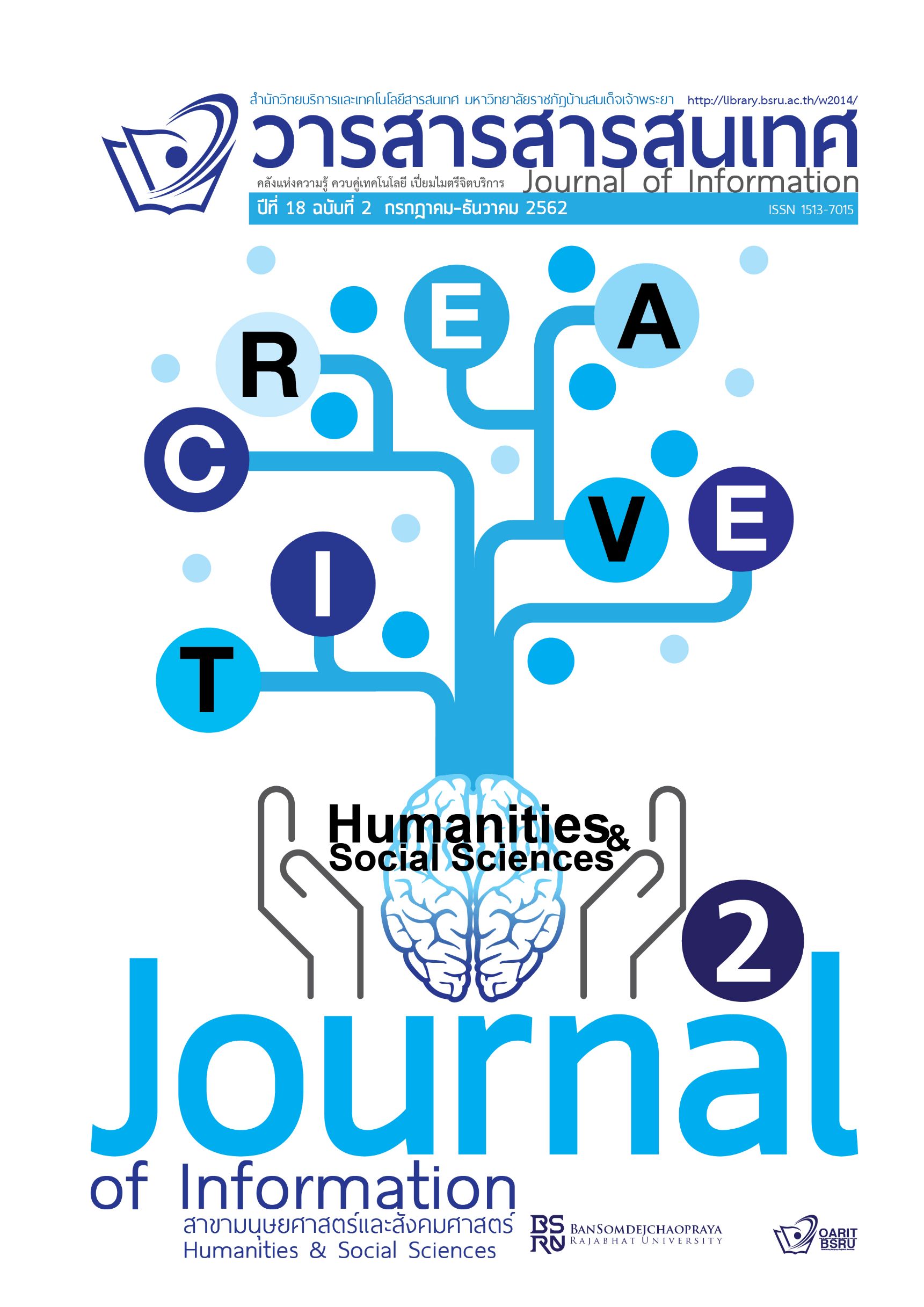Inheritance and Techniques for Farang Khoo Dance on the Play Aunnarut Story
Keywords:
Farang Khoo dance, Aunnarut, Techniques for danceAbstract
This article aims to 1. study widespread of the play Aunnarut both of literature type and performance 2. study elements and FarangKhoo dance posture on the play Aunnarut through inheritance from teacher Venika Boonnak and 3. analyze techniques for FarangKhoo dance on the play Aunnarut performance by defining studying scope in FarangKhoo dance posture on the play Aunnarut performance through style of teacher Lamoon Yamakupta by studying dance posture with teacher Venika Boonnak, National Artist in Thai Dance in the year 2558. Research methodology be qualitative by studying from books, texts, related articles and taking field study in dance posture self-practising for data collecting to analyze and conclude results of studying.
The results were found that 1. The play Aunnarut occurred since Ayudhaya era, be the play of King Rama I and be published in performance until this present time by later on FarangKhoo dance be popular shown as individually 2. Elements in performance consisted of the best basic skills in dance of performers and be able to dance with mini fans for adding pleasure in performance, PhraAunnarut costume would wear yellow and red long sleeve shirt and Nang Usa wear red and green blanket, for dance posture be still conserved LakornNai tradition 3.Techniques for FarangKhoo dance on the play Aunnarut performance were as follows 1) Technique of dance in pair to show 2 performers' skills for present out dance style, emotion and beauty of dance posture 2) Technique of interaction between actor and actress for getting the dance in natural and virtual 3) Technique for conveying emotions to the audience in the mood of the show
References
กรุงเทพฯ: สถาบันบัณฑิตพัฒนศิลป์.
กรมส่งเสริมวัฒนธรรม. (2558). ศิลปินแห่งชาติ พุทธศักราช 2558. กรุงเทพฯ: รุ่งศิลป์การพิมพ์ (1977).
เชิดชาย บุตดี. (2555, กันยายน-ธันวาคม). ตำนานอุษาบารส ฉบับวัดพระพุทธบาทบัวบก พัฒนาการของ
ตัวบท และการอธิบายความหมายของพื้นที่ภูมิศาสตร์. สารสารสังคมลุมน้ำโขง, 8(3), 167-190.
ดำรงราชานุภาพ, สมเด็จพระเจ้าบรมวงศ์เธอ กรมพระ. (2507). ตำนานละครอิเหนา. ธนบุรี:
ป.พิศนาคะ การพิมพ์.
ทิพารินทร์ เลิศฤทธิ์วิมานแมน. (ผู้ถ่ายภาพ). (2562). การจับพัดแบบคว่ำมือ [ภาพถ่าย]. กรุงเทพฯ:
สาขาวิชานาฏศิลป์ไทยศึกษาคณะศิลปศึกษา สถาบันบัณฑิตพัฒนศิลป์.
----------. (2562). การจับพัดแบบหงายมือ [ภาพถ่าย]. กรุงเทพฯ: สาขาวิชานาฏศิลป์ไทยศึกษา
คณะศิลปศึกษา สถาบันบัณฑิตพัฒนศิลป์.
----------. (2562). การจับพัดแบบรวบหุบพัด [ภาพถ่าย]. กรุงเทพฯ: สาขาวิชานาฏศิลป์ไทยศึกษา
คณะศิลปศึกษา สถาบันบัณฑิตพัฒนศิลป์.
----------. (2562). การจับพัดแบบเตรียมคลี่พัด [ภาพถ่าย]. กรุงเทพฯ: สาขาวิชานาฏศิลป์ไทยศึกษา
คณะศิลปศึกษา สถาบันบัณฑิตพัฒนศิลป์.
----------. (2562). การจับพัดแบบขนานพื้น [ภาพถ่าย]. กรุงเทพฯ: สาขาวิชานาฏศิลป์ไทยศึกษา
คณะศิลปศึกษา สถาบันบัณฑิตพัฒนศิลป์.
ประพัฒน์พงศ์ ภวูธน. (2547). วิธีการสืบทอดท่ารำในยุครัตนโกสินทร์: กรณีศึกษาชุดรำเชิดฉิ่งศุภลักษณ์
(รายงานผลการวิจัย). กรุงเทพฯ: มหาวิทยาลัยราชภัฏสวนสุนันทา.
ประเมษฐ์ บุณยะชัย และคณะ. (2548). คุณานุสร ครบ 100 ปี ลมุล ยมะคุปต์. ม.ป.ท.: ม.ป.พ.
พระมหานาค วัดท่าทราย. (2503). บุณโณวาทคำฉันท์. ม.ป.ท.: ม.ป.พ..
พุทธยอดฟ้าจุฬาโลก, พระบามสมเด็จ พระ. (2545). บทละครเรื่องอุณรุท. กรุงเทพฯ:
โรงพิมพ์คุรุสภาลาดพร้าว.
ราชบัณฑิตยสถาน. (2550). พจนานุกรมไทยสมัยอยุธยา อนิรุทธคำฉันท์. กรุงเทพฯ: ทีฟิล์ม.
สุภาวดี โพธิเวชกุล. (2550). การศึกษากลุ่มคำศัพท์ที่ใช้เรียกการปฏิบัติท่ารำที่ไม่ถูกต้อง และวิธีแก้ไขอวัยวะ
ในการปฏิบัติท่ารำให้ถูกต้องตามมาตรฐานนาฏศิลป์ไทยแบบหลวง (รายงานการวิจัย). กรุงเทพฯ:
มหาวิทยาลัยราชภัฏสวนสุนันทา.
สุรพล วิรุฬห์รักษ์. (2543). วิวัฒนาการนาฏยศิลป์ไทยในกรุงรัตนโกสินทร์ พ.ศ. 2325-2477. กรุงเทพฯ:
สำนักพิมพ์แห่งจุฬาลงกรณ์มหาวิทยาลัย.
โอเคเนชั่น. (2551). Feng _shui. สืบค้น 18 พฤศจิกายน 2561, จาก https://oknation.nationttv
tv/blog/buzz/2008/07/01/entry-1/comment
Downloads
Published
How to Cite
Issue
Section
License
บทความ ข้อความ ภาพประกอบ และตารางประกอบที่ลงพิมพ์ในวารสารเป็นความคิดเห็นส่วนตัวของผู้นิพนธ์ กองบรรณาธิการไม่จำเป็นต้องเห็นตามเสมอไป และไม่มีส่วนรับผิดชอบใดๆ ถือเป็นความรับผิดชอบของผู้นิพนธ์เพียงผู้เดียว






